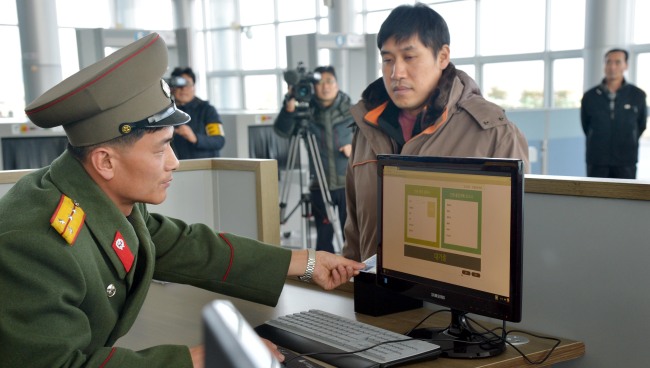Gaeseong launches electronic entry system
Radio frequency identification scheme expected to facilitate cross-border travel
By Shin Hyon-heePublished : Jan. 28, 2014 - 20:03

GAESEONG ― The two Koreas introduced an electronic identification system to their joint factory park in Gaeseong on Tuesday, marking a major operational step forward which will facilitate travel for South Korean businesspeople.
More than 20 people crossed the border early in the morning through the radio frequency identification system in a test-run, where they scanned their ID cards embedded with an electronic chip for a faster and easier immigration procedure.
In the past, South Koreans were required to notify the North with detailed travel plans three days in advance. Then North Korean authorities at the customs office checked the names one by one against their paper list.
Those who failed to arrive on time had to wait for another three days or at least hours before receiving approval. Now they need only report the new entry date.
“The process has apparently become better and easier, compared with the past when we were supposed to fill out a document. I hope it will make further progress,” said Choi Jae-woong, chief of the metropolitan area at the state-run Korea Water Resources Corp., which provides purification and sewage services in the border city.
The 490 million won ($45,400) scheme will pare the average processing time from 13 seconds to five for those on foot, and from 15 seconds to seven for vehicles, the Unification Ministry said.
The new system is a centerpiece of the August deal that reopened the Gaeseong industrial complex after a five-month freeze, along with the envisioned adoption of Internet and mobile phone services. It was initially meant to be introduced by the end of last year but was held back chiefly by Pyongyang’s reluctance and lingering cross-border tension.
The two sides plan to scrap the manual immigration method after a days-long test operation, a ministry official said. They are also scheduled to meet next month to discuss communication and customs issues.
Businesses running plants in Gaeseong have long complained about the three-day advanced notice for entry, a lack of wireless communications and Web services, and time-consuming customs clearance, among other issues.
“We’ve just completed the first step,” said Kim Jung-ho, head of passage at the Gaeseong industrial district management committee. “What we’re seeking next is to allow all of us to travel freely to the complex without having to submit any travel plans beforehand.”
The breakthrough came as the communist state ratchets up its peace offensive in line with leader Kim Jong-un’s call for inter-Korean reconciliation in his New Year speech.
The regime last week proposed holding the first reunions of separated families in more than three years for the upcoming Lunar New Year holidays.
By Shin Hyon-hee and Joint Press Corps
(heeshin@heraldcorp.com)











![[Hello India] Hyundai Motor vows to boost 'clean mobility' in India](http://res.heraldm.com/phpwas/restmb_idxmake.php?idx=644&simg=/content/image/2024/04/25/20240425050672_0.jpg&u=)







